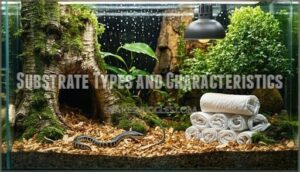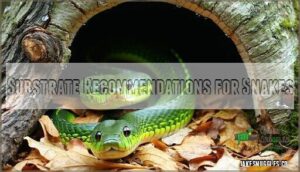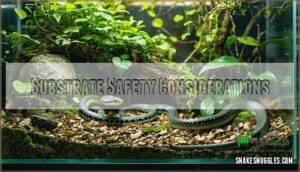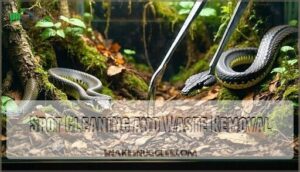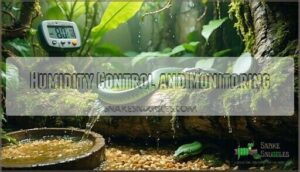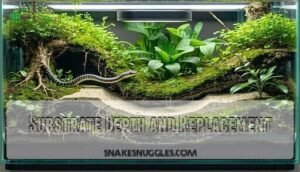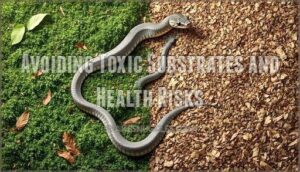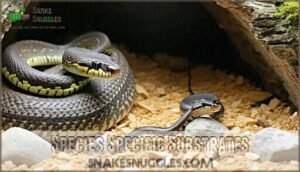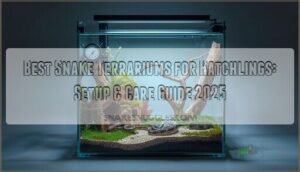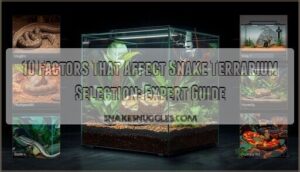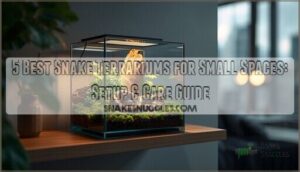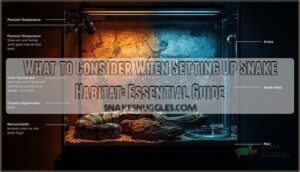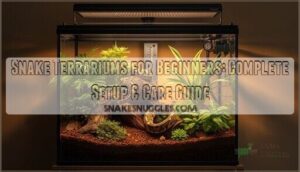This site is supported by our readers. We may earn a commission, at no cost to you, if you purchase through links.
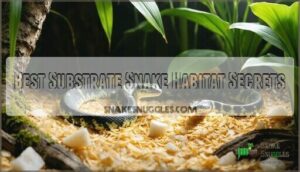 You’ll want to focus on natural materials that mirror your snake’s wild environment when selecting the best substrate snake habitat foundation.
You’ll want to focus on natural materials that mirror your snake’s wild environment when selecting the best substrate snake habitat foundation.
Aspen shavings work brilliantly for most species since they’re dust-free, hold burrows well, and control odors naturally.
Coconut husk and cypress mulch excel at maintaining humidity for tropical species, while paper towels offer a clean, temporary solution during quarantine periods.
Avoid cedar and pine shavings – they’re toxic to reptiles.
Consider your snake’s origin: desert species thrive on sand mixes, while forest dwellers prefer bark-based options.
The right substrate isn’t just bedding – it’s the foundation of your snake’s comfort and health, affecting everything from shedding success to stress levels, and is crucial for maintaining the right environment for your snake’s well-being, including its wild environment.
Table Of Contents
- Key Takeaways
- Choosing Best Substrate
- Top 5 Substrate Options
- Substrate Maintenance Tips
- Species Specific Substrates
- Frequently Asked Questions (FAQs)
- What is the best substrate for a snake enclosure?
- What is the best bedding to use for a snake?
- What should I put at the bottom of my snakes cage?
- What substrate do house snakes like?
- Can I mix different substrates together safely?
- How often should substrate be completely replaced?
- What substrate depth works for burrowing snakes?
- Do bioactive substrates work for snake enclosures?
- Which substrates help control enclosure odors best?
- Conclusion
Key Takeaways
- Match substrate to your snake’s natural habitat – Desert species need sand-based substrates, while forest dwellers require bark or mulch options, and tropical species thrive with humidity-retaining materials like coconut husk or cypress mulch.
- Prioritize safety by avoiding toxic materials – Never use cedar or pine shavings, as they are toxic to reptiles, and choose substrates that will not cause impaction if accidentally ingested by your snake.
- Provide proper depth for your snake’s behavior – Burrowing species need 4-6 inches of substrate for natural tunneling, while non-burrowing snakes only require 1-2 inches for basic comfort.
- Maintain regular cleaning schedules and humidity control – Spot clean waste daily, monitor humidity levels with a hygrometer, and completely replace the substrate every 1-3 months to prevent odors and bacterial growth.
Choosing Best Substrate
You’re about to create a perfect habitat for your snake, and choosing the best substrate is essential.
You’ll need to evaluate factors like humidity, burrowing, and safety to select a substrate that meets your snake’s specific needs.
Substrate Types and Characteristics
Understanding different snake substrate types helps you create the perfect reptile enclosure substrate for your scaly friend.
Each material offers unique benefits that directly impact your snake’s health and comfort.
Here are five key substrate characteristics to examine:
- Absorbency Levels – Paper towels excel at waste absorption, while sand struggles with moisture management
- Humidity Retention – Coconut husk maintains 65-75% humidity, perfect for tropical species
- Burrowing Comfort – Aspen shavings provide excellent digging opportunities with minimal dust
- Odor Control – Cypress mulch naturally resists mold and controls unpleasant smells effectively
- Cost Analysis – Newspaper offers budget-friendly options, while orchid bark costs substantially more
Your best snake substrate choice depends on matching these properties to your snake’s natural habitat needs.
Selecting the right substrate is critical, as it can substantially affect cell attachment and morphology.
Substrate Recommendations for Snakes
Your best snake substrate recommendations depend on your species’ specific needs.
Aspen shavings work well for corn snakes and kingsnakes, offering excellent substrate digestibility and burrowing opportunities.
Ball pythons thrive with cypress mulch or coconut fiber for humidity control.
Cost analysis shows newspaper and paper towels as budget-friendly options, while reptichip provides bioactive benefits.
Consider odor control and aesthetic appeal when choosing your top snake substrate recommendations for ideal snake bedding recommendations.
For corn snakes, a substrate layer of at least three inches is recommended to facilitate burrowing and provide a comfortable environment with good humidity control.
Substrate Safety Considerations
Substrate safety isn’t just snake oil; it’s the backbone of healthy habitats.
Even the friendliest snake bedding options can surprise you with hidden dangers.
For example, humidity control is essential for respiratory health and shedding.
Snake-proof your setup by keeping an eye out for:
- Impaction Risks from sand or larger chips
- Toxic Materials like CCA-treated wood
- VOC Exposure from artificial liners
- Abrasiveness Concerns
- Ingestion Hazards—choose non toxic snake bedding
Top 5 Substrate Options
You’re looking for the best substrate options for your snake’s habitat, and you want to make an informed decision.
You’ll find the top 5 substrate options, including Prevue Hendryx Cage Liner Roll and Zoo Med Aspen Snake Bedding, which are popular choices among snake owners.
These options can help you create a comfortable and safe environment for your pet.
1. Prevue Hendryx Cage Liner Roll
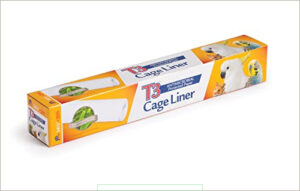
You’re considering the Prevue Hendryx Cage Liner Roll for your snake’s habitat.
This durable, antimicrobial liner is easy to use and provides a healthy environment.
Made in the US, it’s a great option for keeping your pet’s cage clean and sanitary.
It’s also resistant to tearing, making it a practical choice for snake owners.
Best For: bird owners, particularly those with parakeets or multiple birds, who want a durable and easy-to-clean liner for their cages.
- Some users note difficulty in unrolling and cutting the product, which can be frustrating.
- The product may be hard to find in certain regions, which can be a problem for those who need it.
- The liner has mixed opinions on the printed side and rolling behavior, which may not be ideal for all users.
- The liner is made from sturdy polyethylene material and has antimicrobial properties for a healthier environment.
- It is easy to clean and reusable, making it a practical choice for pet owners.
- The product is pet-safe, environmentally friendly, and unscented, providing a comfortable environment for birds.
2. Zoo Med Aspen Snake Bedding
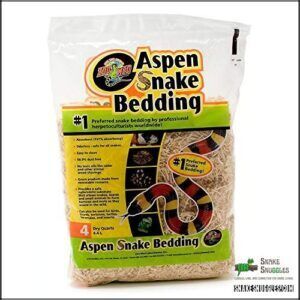
Zoo Med’s Aspen Snake Bedding delivers exceptional performance for snake keepers who prioritize their pet’s health and comfort.
Zoo Med’s Aspen Snake Bedding sets the gold standard for snake keepers who demand the best.
This 4-quart package offers 191% absorbency, making it highly effective at managing moisture and waste.
You’ll appreciate its 99.9% dust-free formula, which protects your snake’s respiratory system from irritation.
Unlike cedar or pine alternatives, it contains no toxic oils that could harm your pet.
The bedding encourages natural burrowing behaviors, particularly benefiting species like corn snakes and ball pythons.
Users consistently praise its odorless nature and easy maintenance requirements.
Best For: Snake owners who prioritize respiratory health and natural behaviors, especially those keeping burrowing species like corn snakes and ball pythons.
- Requires careful moisture management to prevent mold growth in humid environments
- May need more frequent replacement compared to other substrates to maintain cleanliness
- Higher cost per volume compared to basic bedding options, though larger sizes offer better value
- 191% absorbency rating effectively manages moisture and waste while maintaining proper humidity levels
- 99.9% dust-free formula protects snake respiratory systems from irritation
- Contains no toxic oils unlike cedar or pine alternatives, making it safe for all snake species
3. Zilla Green Reptile Terrarium Liner
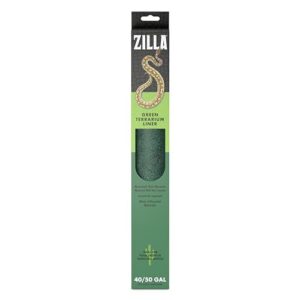
A green liner, like the Zilla Green Reptile Terrarium Liner, makes cleaning your snake’s home almost as easy as pie.
You’ll appreciate its absorbent, non-abrasive fabric that’s gentle on scales and easy on your nerves. Enzyme treatments keep odors in check—no more holding your nose on cleaning day!
Just cut to size, rinse, and reuse. Although it’s not fit for burrowers, this liner is a solid pick if you want simplicity, less mess, and an affordable, safe alternative to loose bedding.
Proper substrates are key for ball python health.
Best For: Snake owners seeking a low-maintenance, easy-to-clean substrate alternative that reduces odors and provides a safe surface for juvenile reptiles.
- Simple maintenance with cold water rinsing and enzyme treatment that reduces odors and bacteria
- Safe for juvenile reptiles by eliminating ingestion risks associated with loose substrates
- Customizable sizing and reusable design makes it cost-effective long-term
- Not suitable for burrowing species or reptiles that require digging substrates
- Material may catch on reptile teeth or nails during normal movement
- Requires periodic deep cleaning with bleach or washing machine to maintain hygiene
4. Reptile Carpet Coconut Fiber Terrarium Liner
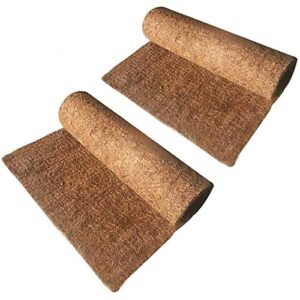
You’re looking for a great substrate option.
The Reptile Carpet Coconut Fiber Terrarium Liner is a fantastic choice, made from 100% natural coconut fiber.
It’s absorbent, non-abrasive, and easy to clean.
This liner is perfect for reptiles, reducing odors and providing a comfortable surface.
It’s also durable and long-lasting, making it a great value for your snake’s habitat.
Best For: reptile owners, especially those with snakes, lizards, turtles, and small mammals, who want a natural, absorbent, and easy-to-clean substrate option.
- The Reptile Carpet Coconut Fiber Terrarium Liner is made from 100% natural coconut fiber, making it a safe and organic choice for pets.
- It’s absorbent, non-abrasive, and easy to clean, reducing odors and providing a comfortable surface for reptiles.
- The liner is durable and long-lasting, making it a great value for pet owners who want a low-maintenance substrate option.
- The product may arrive folded or rolled, requiring flattening and potentially leaving bumps or creases.
- Some users have reported minor fiber shedding or issues with the liner’s stiffness.
- The liner may not be as effective at odor control as some other substrate options, requiring more frequent cleaning and maintenance.
5. Zilla Coconut Husk Reptile Bedding
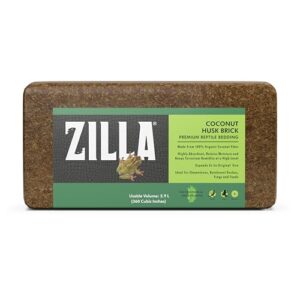
In terms of keeping your snake’s home humid and cozy, Zilla Coconut Husk Reptile Bedding hits the mark.
Made from 100% organic coconut fiber, it holds moisture well—think rainforest vibes in your terrarium.
Just add hot water, watch it expand, and you’ve got a soft, burrow-friendly layer that’s easy to clean and eco-friendly.
Perfect for Ball Pythons or Corn Snakes, but skip it for lizards who don’t like bits sticking to them.
Store dry, check humidity, and compost after use.
Best For: Snake owners wanting a natural, humidity-retaining bedding for tropical or semi-arid species like Ball Pythons or Corn Snakes.
- Organic coconut fiber is eco-friendly and compostable.
- Encourages natural burrowing and keeps humidity high.
- Simple to set up; expands easily when hydrated.
- Not recommended for lizards or tortoises as it can stick to moist areas.
- Requires regular monitoring to maintain humidity.
- Needs dry storage to prevent premature absorption.
Substrate Maintenance Tips
You’ll keep your snake healthy and stress-free by staying on top of substrate maintenance, from spot cleaning to monitoring humidity.
It’s not glamorous, but a regular cleaning routine means fewer smells, happy reptiles, and a habitat that won’t surprise you with mysterious science experiments growing under the surface, which helps maintain a stress-free environment.
Spot Cleaning and Waste Removal
After picking your favorite liner or bedding, it’s time to master spot cleaning.
Scan for snake droppings daily—quick waste identification prevents odors and keeps your habitat fresh.
Use long tweezers or scoops for easy waste removal.
Frequency matters: daily spot cleaning snake substrate beats weekly deep cleans for odor prevention, better hygiene practices, and simple substrate maintenance, which supports better hygiene and allows for simple substrate care.
Humidity Control and Monitoring
Your hygrometer becomes your best friend when maintaining proper humidity levels for your snake’s health.
Digital humidity sensors provide accurate readings, while strategic misting frequency keeps moisture balanced without creating soggy conditions.
Proper enclosure ventilation prevents stagnant air that breeds problems, and a digital snake hygrometer can help maintain the correct levels.
Good humidity control directly impacts your snake’s hydration and shedding success, making humidity monitoring essential for substrate performance.
Substrate Depth and Replacement
Your snake’s substrate depth affects its comfort and health. Burrowing species need 4-6 inches for natural behavior, while non-burrowing snakes do fine with 1-2 inches.
Full substrate replacement every 1-3 months keeps your habitat fresh and prevents bacterial growth.
- Burrowing Depth: Sand boas and hognose snakes require 6+ inches for tunneling comfort
- Replacement Frequency: Monthly changes work for most setups, but heavily soiled substrates need immediate attention
- Bioactive Depth: Living substrate systems need 6-8 inches to support beneficial microorganisms and plants
Avoiding Toxic Substrates and Health Risks
Toxic-substrate exposure threatens your snake’s health through multiple pathways.
Choose wrong, risk your snake’s life—toxic substrates kill through hidden dangers.
Cedar shavings release phenols causing respiratory issues, while sand creates impaction dangers. Abrasive substrates damage delicate scales and airways. VOC exposure from synthetic materials triggers allergen risks in sensitive species.
Selecting appropriate bedding, like cypress bedding options, is essential for burrowing species.
| Substrate Type | Primary Health Risk | Severity Level |
|---|---|---|
| Cedar/Pine Shavings | Respiratory Issues & Liver Damage | High |
| Sand/Gravel | Impaction Dangers & Bacterial Growth | High |
| Synthetic Carpets | VOC Exposure & Allergen Risks | Medium |
| Walnut Shells | Abrasive Substrates & Mold Growth | Medium |
Species Specific Substrates
You’ll need to match your substrate choice to your snake’s specific requirements for ideal health and behavior.
Different species have evolved distinct habitat preferences that directly influence their substrate needs, from moisture retention to burrowing depth, which is crucial for their well-being and involves moisture retention.
Corn Snake Substrate Requirements
With corn snakes, finding a substrate that checks all the boxes can feel like searching for buried treasure. Here’s your quick guide:
- Aim for 3–4 inches depth for Burrowing Needs.
- Use aspen snake bedding for great Absorbency Levels and Odor Control.
- Skip pine—it’s risky.
To find the best options, explore various brands online.
- Compare Cost and Aesthetical Appeal; aspen is top value snake substrate.
Garter Snake Substrate Needs
Don’t gloss over Burrowing Depth—garter snake substrate should be 1–2 inches deep, giving your buddy just enough fluff for moderate tunnels.
Blend half play sand with coconut fiber for steady Humidity Levels in any Naturalistic Setup.
Appropriate food items like nightcrawlers are essential for their diet.
Watch for Substrate Ingestion—behavior can show health issues. Compare costs: aspen shavings and Sani-chips are budget-friendly snake bedding options for your snake habitat setup.
Boa Constrictor Substrate Preferences
If you thought garters loved burrowing, boas take it a step further.
Lay down 2–3 inches of boa substrate like coconut husk, cypress mulch, or aspen shavings for prime burrowing needs and humidity levels.
Ditch pine and cedar—opt for a humidity snake substrate that supports naturalistic setups and easy cleaning.
Many owners purchase boa constrictor bedding online.
Your boa constrictor will appreciate the cost analysis and aesthetical appeal, too!
Ball Python Substrate Recommendations
Boa constrictors have their pick, but ball pythons really shine with humidity snake substrate.
You want loose snake substrate to meet burrowing needs, control odors, and reduce impaction risks.
Go for cypress mulch or coconut husk—these hold humidity levels steady.
Clean weekly and weigh in on cost analysis, especially as substrate for ball python adds up.
- Cypress mulch supports odor control.
- Coconut husk maintains humidity levels.
- Loose substrate helps with ball python burrowing needs.
Kingsnake Substrate Options
Kingsnakes thrive with 2-3 inches of substrate for king snake enrichment and burrowing behavior.
Aspen shavings provide excellent odor control and cost comparison advantages over premium options.
Cypress mulch and ReptiBark create naturalistic setups while preventing substrate ingestion.
Eco Carpet offers easy maintenance for busy keepers.
Avoid moisture-retaining substrates—kingsnakes prefer dry conditions.
This natural snake substrate approach supports healthy digging instincts.
Frequently Asked Questions (FAQs)
What is the best substrate for a snake enclosure?
Like choosing the perfect foundation for your home, selecting substrate sets the stage for your snake’s comfort.
Aspen shavings work great for burrowing species, while cypress mulch suits humid environments.
Paper towels offer simplicity for beginners.
What is the best bedding to use for a snake?
You’ll want aspen shavings for burrowing snakes, cypress mulch for humid species, or paper towels for beginners. Choose based on your snake’s natural habitat needs and humidity requirements.
What should I put at the bottom of my snakes cage?
Smart substrate selection starts with species-specific needs. You’ll want aspen shavings for burrowing snakes, cypress mulch for humidity-loving species, or paper towels for beginners and quarantine situations.
What substrate do house snakes like?
House snakes thrive with aspen shavings or cypress mulch as substrate.
You’ll want 1-2 inches depth for comfortable burrowing.
These options absorb moisture, control odors, and won’t harm your snake if accidentally ingested, which is a complete concept for a safe environment.
Can I mix different substrates together safely?
Yes, you can safely mix certain substrates together.
Combining aspen shavings with coconut fiber creates excellent drainage while maintaining humidity.
Mix cypress mulch with paper towels for easy cleaning.
Avoid mixing anything with cedar or pine shavings though.
How often should substrate be completely replaced?
You should completely replace your snake’s substrate every 1-3 months, depending on how soiled it becomes.
Monitor for odors, mold growth, and waste buildup to determine the right timing for replacement.
What substrate depth works for burrowing snakes?
Burrowing snakes need deeper substrate than their non-burrowing cousins. You’ll want to provide 4-6 inches of substrate like aspen shavings or cypress mulch for proper tunneling behavior.
Do bioactive substrates work for snake enclosures?
Nearly 40% of snake keepers switch to bioactive setups within their first year.
You’ll find bioactive substrates work excellently for snake enclosures, requiring deeper layers (6+ inches) to support beneficial bacteria and cleanup crews that naturally process waste.
Which substrates help control enclosure odors best?
Aspen shavings and cypress mulch excel at controlling odors by absorbing waste and urates effectively. You’ll find these substrates naturally combat smell while providing comfortable burrowing opportunities for your snake.
Conclusion
Successfully selecting the best substrate snake habitat transforms your terrarium into a thriving ecosystem that mirrors nature’s design.
You’ve learned that species-specific needs matter most—desert dwellers require different foundations than forest species.
Remember to prioritize safety by avoiding toxic materials, maintain proper humidity levels, and establish regular cleaning schedules.
Your snake’s comfort depends on these substrate choices, directly impacting shedding success and overall health. Choose wisely, and your serpent companion will reward you with natural behaviors.
- https://kundoc.com/pdf-salmonellae-from-a-pet-snake-and-its-bedding-.html
- https://reptilesmagazine.com/kenyan-sand-boa-information-and-care/
- https://thepetsuperstore.com.au/products/natural-coconut-fiber-reptile-mat
- https://www.reddit.com/r/snakes/comments/10k6j8c/vet_told_me_not_to_use_coconut_fiber_as_substrate/
- https://talis-us.com/blogs/news/maintaining-optimal-humidity-for-corn-snakes

